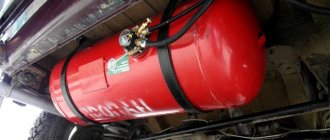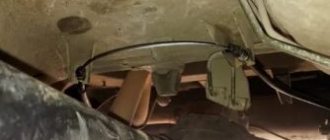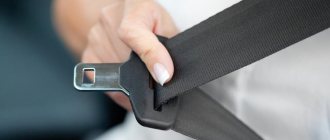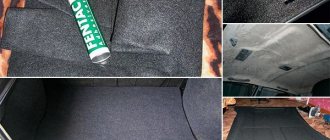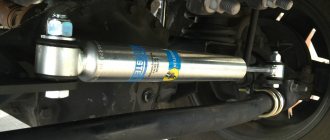How to connect the vehicle's ground switch? And this can be done
A common question is how to connect the car's ground switch. After all, not every modern car has such a useful function. And people regularly encounter dead batteries after parking for several days. After all, a car has a lot of different equipment that is constantly connected to the battery. And even in economy mode, energy consumption is constant. Also, the risk of electrical equipment breakdowns and current leakage through damage to the insulation cannot be excluded. In all these cases, such a switch will not be superfluous, so experienced car enthusiasts recommend installing such a device in the car.
Connecting ground to bypass the alarm
If you want to use mass shutdown with simultaneous alarm operation. So, you'll have to tinker a little. An additional wire is attached to the negative terminal; for this purpose, you can choose one that is not too thick. A fuse is cut into it, and this structure is screwed to the body.
This will be enough for the alarm to work, but when you try to start the engine or turn on any other equipment, the fuse will simply burn out. Thus, if the ground is connected, it will not be possible to start the engine; with any attempt, the car will simply be de-energized.
Terminal care
To maintain battery terminals in working condition, it is necessary to take proper care of them in a timely manner. To do this, do the following:
Prevention should be carried out at least 2 times a year. Experienced motorists recommend doing this in spring and autumn.
When it is not recommended to use a button
In some cases, connecting ground is simply not possible. The reason is due to the technical characteristics of cars. In some modern cars, the engine control unit does not respond well when the power is disconnected. In this case, he begins to suspect a malfunction, and after the power is returned, he simply starts testing, preventing the engine from starting.
To avoid such problems, before installing the switch, study the features of the vehicle's electrical system. If necessary, you can apply a negative voltage to the block using a wire and a fuse.
Conclusion
. Many car enthusiasts regularly turn off the power to their car for various reasons. Usually, to do this, remove one of the terminals from the battery. But, having exhausted themselves with this everyday procedure, they begin to wonder how to connect the car's ground switch. In fact, it's all quite simple, you just need to choose the right place and connect everything carefully.
How to connect the mains switch
There is no need to tell experienced drivers about the benefits of the mass switch. This device protects the battery from discharge during long periods of parking, and also, when installed correctly, acts as a simple anti-theft system.
Figuring out how to install the mains switch correctly is not difficult. But if you are not particularly good at electrical circuits, it is better to leave this work to professionals or get preliminary advice from them.
How to install a battery disconnect switch on a car?
The main switch is mounted next to the battery or directly on it and performs the function of preventing the leakage of electrical charge from the battery. If there is also a fuse on the switch, the car’s electrical system is not completely de-energized. In this case, the alarm siren, central locking, on-board computer and radio remain powered. But if an attacker takes on the job, his attempt to start the engine will most likely end in failure, because the starting current of the starter blows the fuse and the car system is de-energized.
Therefore, if you have already started looking for how to install a mass switch, you should contact a specialized store where you can find several suitable options. The simplest is a terminal with a built-in switch. But here it is important that it can withstand the load coming from your battery. Otherwise, damage or even fire may occur.
If you have decided on the model of the mass switch, experts will best tell you how to install it. To do this, disconnect the terminal from the ground and the positive terminal of the battery. The next step is to disconnect the terminal from the wire. Just save it in case you no longer need the mains switch in the future.
Check the condition of the battery, electrolyte level, and carry out maintenance. The mains switch should be connected to the negative terminal of the battery and securely fastened. Also connect the power wire to the positive terminal.
The ground wire is connected to the switch in accordance with the instructions included in the delivery kit. Turn off the device and try to start the engine. If everything is working properly, after turning off the ignition, turn on the power switch. If you were able to properly connect the remote master switch, all vehicle systems will be powered when you turn the key, but attempting to start the engine will cause the fuse to blow.
How to connect the mains switch on a car with a modern electrical system?
In many new models, an unplanned battery disconnection can lead not only to resetting the computer, radio and clock, but also have a negative impact on the quality of engine starting. Therefore, if you are not fluent in the science of electrical engineering, it is better to leave this work to specialists or order modifications from a dealer.
Where is the mass located on other brands of cars?
There are a huge number of car models in use in the country and each has its own characteristics. At the same time, the same principles are used in all cars, which greatly simplifies the work of troubleshooting problems with weight on the car. It is impossible to understand each brand specifically, since it will take hundreds of pages; it is much easier to understand the general principles:
For a quality check, it is better to use a multimeter. It happens that the contacts are reliable, but a wire breaks, which cannot be detected under the insulation. With the help of measurements it is easy to check whether the voltage is coming.
Regardless of the brand and model, the principle of connecting the mass is always the same; you can do the job without any experience. This does not require complex equipment or special knowledge. Poor contact on the body is visible to the naked eye, and often the nut or bolt that secures the terminal simply loosens.
Features of connecting and using the battery disconnect switch
The battery disconnect switch was often used by car enthusiasts on Soviet cars in the 70-80s of the last century. It simultaneously performed two functions:
p, blockquote 1,0,0,0,0 —>
- a simple anti-theft device;
- preventing battery leakage currents and its discharge while the car is parked.
p, blockquote 2,0,0,0,0 —>
The mass switch (BM) was purchased and installed, as they say now, as additional equipment.
p, blockquote 3,0,0,0,0 —>
p, blockquote 4,0,0,0,0 —>
Recommendations and instructions for installing a battery disconnect switch on a vehicle
Battery disconnect switches became quite widespread about 40 years ago. They were installed on Soviet and imported cars.
The switch had 2 main tasks. This is the organization of a rather simple but effective anti-theft system, as well as protection against current leakage while the vehicle is parked.
Currently, the tasks facing such devices have not changed. At the same time, many motorists continue to be interested in the possibility of installation.
Purpose
p, blockquote 5,0,0,0,0 —>
The main purpose of the mass switches has not changed since the last century:
p, blockquote 6,0,0,0,0 —>
- disconnecting the battery from the on-board network during parking;
- if there are two batteries in the vehicle, disconnect the backup battery;
- as a simple anti-theft device.
Modern car thieves have forgotten about the simplest tricks of car enthusiasts, so if you properly hide the VM in the engine compartment, this option may not occur to them.
p, blockquote 7,0,0,0,0 —>
In modern cars, stuffed with electronic devices and units, current leaks often occur while the car is parked, which are difficult to eliminate. Main consumers of current during parking:
p, blockquote 8,0,0,0,0 —>
- car radio;
- security device (car alarm);
- body control unit.
adsp-pro-1 —>
It is considered normal if a car consumes up to 200 milliamps of current while parked (usually about 20-70 milliamps). For a day this is about 5 ampere-hours, for 10 days - 50 ampere-hours. That is, after 10 days of parking, a car battery can be almost completely discharged. This usually happens in about a month. Thus, if you leave the car for a long winter, the battery will be discharged to almost zero in the spring. This is very dangerous from the point of view of sulfation of the plates, which leads to complete failure of the battery.
p, blockquote 9,0,1,0,0 —>
The main switch allows you to avoid battery discharge due to leakage currents during parking.
p, blockquote 10,0,0,0,0 —>
VMs are widely used in agricultural machinery, for example, for tractors:
p, blockquote 11,0,0,0,0 —>
p, blockquote 12,0,0,0,0 —>
And on heavy-duty equipment - for example, a KAMAZ remote load switch:
p, blockquote 13,0,0,0,0 —>
p, blockquote 14,0,0,0,0 —>
Features of installing a car battery mass switch
Not all car enthusiasts know, but in fact, mass switches began to be actively used several decades ago. Moreover, they were installed on both domestic cars and foreign cars.
Switches of that time performed 2 main functions. In fact, it was a simple but very effective security system. To be more precise, it protected against possible theft, since at that time modern means did not yet exist. Plus, the switch made it possible to avoid current leakage during long-term parking of the vehicle.
It is hardly surprising that after about 40 years the functions of the mains switches have not changed at all. The quality of the devices themselves has improved and the range has expanded. Many car enthusiasts continue to show increased interest in them.
Types and connection diagrams of the battery mass switch
p, blockquote 15,0,0,0,0 —>
The following types of VMs are currently used:
p, blockquote 16,0,0,0,0 —>
- manual mechanical;
- remote electromechanical (relay);
- thyristor.
Manual mechanical VMs are used on heavy vehicles and special equipment. They are designed for high currents (up to 1000 Amperes), so they can be used for switching starting circuits for powerful motors. Such switches can be successfully used in passenger cars.
p, blockquote 17,0,0,0,0 —>
You can install the VM at the point where the negative terminal of the battery is connected to the car body, if this place is within reach for turning on.
p, blockquote 18,0,0,0,0 —>
More convenient are VMs located on the battery terminals, designed specifically for passenger cars.
p, blockquote 19,1,0,0,0 —>
p, blockquote 20,0,0,0,0 —>
Remote disconnect switches are often used in cars and trucks. They can be controlled from inside the car. In this case, if you place the control button in a secret way, you get a good anti-theft device.
p, blockquote 21,0,0,0,0 —>
The button can be designed for a high current of direct control of the VM electromagnet, as shown in the diagram.
p, blockquote 22,0,0,0,0 —>
p, blockquote 23,0,0,0,0 —>
If you use an additional relay in the circuit, you can use low-current control (a small button).
p, blockquote 24,0,0,0,0 —>
p, blockquote 25,0,0,0,0 —>
In passenger cars, powerful thyristors with currents of 160, preferably 320 Amperes, can be used as VMs. In this case, control can be organized secretly using a reed switch-magnet system. But the thyristor control circuit may not withstand high motor starting currents.
p, blockquote 26,0,0,0,0 —>
p, blockquote 27,0,0,0,0 —>
You can use a thyristor control circuit with two buttons and a relay.
p, blockquote 28,0,0,1,0 —>
p, blockquote 29,0,0,0,0 —> adsp-pro-2 —>
Recommendations for use
p, blockquote 30,0,0,0,0 —>
When installing the battery disconnect switch, consider the following recommendations:
p, blockquote 31,0,0,0,0 —>
1. It is extremely undesirable to install VM on passenger cars manufactured after the 2000s. Its accidental activation when the ignition is on can lead to “decoupling” of the immobilizer (loss of the software code connection with the chip and the body control unit). Restoring this function and starting the engine is only possible with the help of a specialist.
p, blockquote 32,0,0,0,0 —>
2. Disabling the mass may lead to loss of multimedia system settings.
p, blockquote 33,0,0,0,0 —>
3. When the power is disconnected, the central locking and car alarm will not work. Failure of the central locking system to operate during winter operation of the vehicle may result in denial of access to the interior, since the standard mechanical lock may freeze.
Useful tips
It’s worth thinking again about whether to install a mass switch or not.
This is due to the following features:
- Some devices and systems, when the power is turned off, can reset their settings and lose previously set parameters. They will need to be restored each time.
- Don’t worry that your odometer will reset to zero or all the settings in the ECU will be completely lost. They are non-volatile.
- When the ground is disconnected, an alarm siren is activated on some machines.
- If the security system does not have its own power source, disconnecting the battery will result in the alarm not working.
- A number of parameters on injection engines are reset and not saved. For example, when using a switch, you may not know about the presence of certain errors.
- There is a risk that the immobilizer will be disconnected from the car. A common occurrence for newer cars.
To summarize, it is worth saying that it is not recommended to use the circuit breaker on cars manufactured after 2000, and especially on injection ones. Too many settings will have to be restored.
Think and make decisions depending on the specific situation and individual circumstances. The switch is potentially useful and necessary. But not always and not for everyone.
Source
Purpose of the remote power switch
While the car is parked, its battery gradually loses charge. The reason for this phenomenon is simple - there are always non-switchable current consumers in the car, of which the alarm system, clock, radio and others consume the most power. And if after a short stay (even for two or three days) the battery is able to provide energy for the starter to operate, then after a week or two the battery may be discharged to zero. Therefore, during long-term parking, it is recommended to disconnect the battery from the on-board network - a special remote switch (or, conversely, a ground switch) is used for this.
A remote power switch is an electromechanical or electronic switching device designed to disconnect the battery from all consumers of the vehicle’s on-board electrical network. This switch, as its name suggests, is controlled remotely using a button in the cab.
Types and design of mass switches
Currently, there are two fundamentally different types of remote mass switches:
- Electromagnetic switches;
- Electronic (thyristor) switches.
Electronic switches are built on the basis of thyristors; they have gained popularity among owners of domestic passenger cars VAZ, Niva and others. Such switches are designed for low currents, so they are not suitable for trucks; for heavy vehicles, electromagnetic switches are used, which will be discussed below.
The basis of the mass switch is a housing (usually cylindrical), which contains three components:
- An electromagnet with an armature and a rod is located in the upper part. Usually the anchor is combined with a button, closed with a sealed rubber cap. On the side of the switch body there are two terminals for supplying current to the winding;
- Latch (mechanism for transmitting force from the armature to the contact device) - located in the middle part, it ensures the transfer of force from the armature to the contact device and fixes the contacts in the closed position (the same mechanism is used in conventional buttons with locking);
- Contact device - located at the bottom of the switch, consists of a contact disk mounted on a latch and two power terminals (threaded with nuts).
The mass switch operates as follows. When a short-term current is supplied to the winding of the electromagnet, its armature is retracted, and the rod connected to it through the latch sets the contact device in motion - the contact disk connects the terminals and the battery is connected to ground. In this case, the latch is installed in this position and ensures constant pressing of the disk to the contacts. After connecting the battery to ground, supplying current to the electromagnet is no longer necessary, since the contact device is held in place by a clamp.
To disconnect the battery from ground, you need to apply current to the electromagnet winding again, the armature will retract again and push the rod onto the latch - in this case, the latch will switch and raise the contact disk. As a result, the battery will be disconnected from ground.
You can also control the switch manually. For this purpose, it has a button that is directly connected to the electromagnet armature. When you press the button, the armature enters the electromagnet winding and all the processes described above occur.
Installation of a battery in PAZ buses
All PAZ buses are equipped with an on-board electrical system with an operating voltage of 12 volts (although there are also 24 V modifications). As a current source for the operation of the starter and the electrical system when the engine is stopped, automotive lead-acid batteries of various sizes are used (usually 353 mm long, but large batteries with a length of 513 mm are often used).
The battery is installed in a special battery compartment. On various models of PAZ buses, the battery compartment is usually located in the same place - on the right side of the bus, to the left of the front entrance door. The compartment is closed with a lid that limits access to the battery and prevents tampering.
In PAZ buses, the battery is installed in such a way as to simplify and speed up the process of removing and replacing it as much as possible. This is achieved using a simple mechanism with a slide on which the battery slides out of the compartment. The basis of the device is a metal box open at the top and front, at the bottom of which there are slide guides on both sides. The front wall of the box is made in the form of a folding frame, the side parts of which are a continuation of the guides located at the bottom of the box. When tilted, the frame is held in place by folding metal braces located on both sides of the box.
The battery is installed on a slide, at the bottom of which there are four rollers. The battery is secured to the slide using a clamping frame installed on the top of the battery and four studs stretched between the slide and the clamping frame. The frame is pressed to the battery using wing nuts.
Installation of the battery is carried out as follows: the battery is placed in the slide and fixed with a frame and “wings”; this structure is installed on folded guides, along which it is pushed into the box until it stops. The front of the box with guides lifts up and locks the battery.
The battery connection is made using long flexible cables that extend into the battery compartment. The terminals are installed on the battery before the valve is inserted into the box, which greatly simplifies this procedure.
Here, in the battery compartment, other additional devices can be located. First of all, there is a remote power switch, which ensures that the battery is disconnected from the on-board power supply during long periods of parking.
Options and features for installing remote power switches
Installing the mass switch is quite simple; here are a few key points to note:
- The switch is most often mounted in the battery compartment of a truck or bus; this is necessary to reduce the length of the “mass” wire;
- The power terminals of the switch are connected to the negative wire going from the battery to the vehicle ground. For this, thick stranded wire designed for high currents is used;
- One terminal of the electromagnet winding is connected to the “−” terminal of the battery;
- The second terminal of the electromagnet winding is connected with a thin stranded wire to a button installed in any convenient place in the car cabin (and this button can be hidden);
- The second terminal of the button is connected to ground using a thin conductor anywhere in the cabin. The “+” contact of any device is selected as this point - radio, ignition switch, relay and fuse box, etc.;
- A button without locking is installed in the cabin, since only a short-term current pulse needs to be supplied to the electromagnet, sufficient to retract the armature and operate the latch.
For safety, the electromagnet winding is connected to the button through a fuse (usually 5 A), and for convenience, it is recommended to install a test lamp between the button and ground. If necessary, the button can be connected to the mains switch via an additional relay; this is justified when using a button designed for low current in trucks and buses with electrical systems that have powerful consumers.
What it is
A device of this type began to be installed on cars back in the days when a single-wire circuit with connection to interconnected structural elements of the vehicle (body, engine, etc.) was chosen as a kind of standard for electrical equipment for cars. The so-called ground began to be connected to the negative terminal of the battery (although sometimes there were exceptions).
The main problem of such an on-board network was imperfect electrical equipment, which often, especially with any damage to the insulation, caused a large current leak and sudden voltage surges. Most often, the car battery suffered from such problems. Therefore, drivers began to disconnect the “negative” terminal from the battery at almost every stop in order to prevent self-discharge and extend the battery life, as well as to avoid short circuits.
The problem is that with regular manipulation, the connection between the terminal and the battery weakened, which had an extremely negative effect on the contact and led to new problems in the operation of electrical equipment. It was then that the first devices appeared that made it possible to turn off the mass from the engine compartment or car interior.
These devices not only protected the battery from “self-discharge” and de-energized the on-board network during stops, but also quite unexpectedly became a good anti-theft device. Of course, finding this switch was not difficult, but the attacker spent time on this and quite often abandoned his intentions for fear of being caught in the act.
The operating principle of these devices is extremely simple. The switch was installed in the gap between the mass of the vehicle and the “minus” of the battery. “Minus” in this case was chosen because, unlike “plus”, it is not under potential. Therefore, during switching on, there is no short circuit or burning of contacts.
Mass switches were quite popular in Soviet times. There were even several types of such devices - from mechanical to electromagnetic models. Nowadays, such devices have been practically forgotten and were done in vain, since in some cases the mass switch on the machine will be very useful.
Typical malfunctions, repair and maintenance of the mass switch
The switch and the entire electrical circuit associated with it are reliable and can serve for many years without problems. However, if the switch is poorly positioned (for example, if it is poorly protected from moisture and dirt), corrosion may occur in it, which will lead to poor contact between the contact disk and the terminals, as well as between the terminals and the wires connected to them. In this case, the switch can be disassembled and cleaned.
Sometimes more serious malfunctions of the switch are possible - breakage of the electromagnet winding, breakage of the latch, sagging or breakage of springs, deformation of the armature rod, and others. In these cases, it is much easier and cheaper to completely replace the switch.
With proper installation and careful operation, the remote main switch will protect the battery from loss of charge and the car from theft for a long time, without requiring any attention.
Signs of lack of mass
If contact is broken or absent, various problems can arise. If they are not eliminated, this can lead to the failure of entire electronic components or excessive heating of connections, which can lead to a fire. The most common symptoms of this malfunction are:
When one device is turned on, another may work. For example, instead of a turn signal, a wiper turns on, etc. Often equipment that is not connected to each other is started at the same time.
There are also other possible problems, it all depends on the model of the machine and the features of its electrical equipment. It often happens that a motorist checks one grounding point, but in fact there are two or more. To completely eliminate the mass problem, you need to find all the elements.

